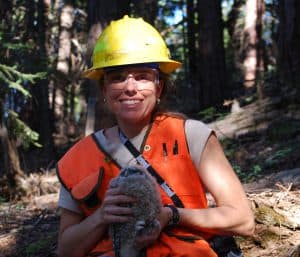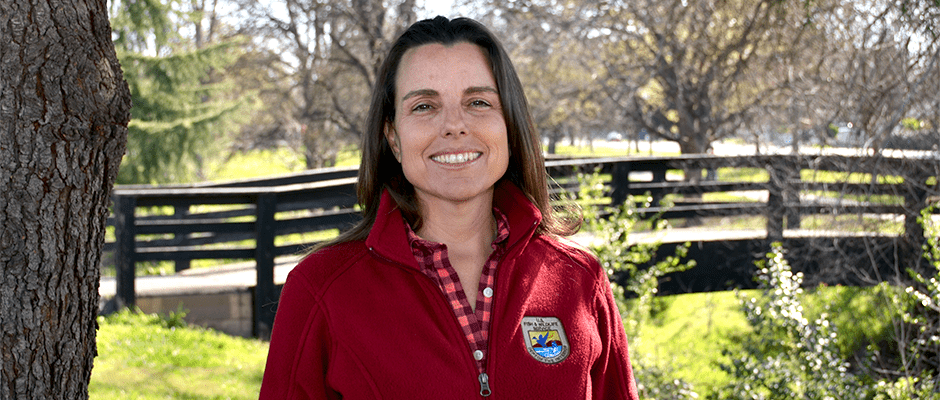Share this article
TWS salutes women in wildlife biology careers: Claudia Funari
The National Women’s History Project, founded in 1980, is a nonprofit educational organization committed to recognizing and celebrating women’s diverse and significant historical accomplishments. Each March, the group highlights the accomplishments of women in all professions. This year’s theme is “Nevertheless She Persisted: Honoring Women Who Fight All Forms of Discrimination Against Women.”
In cooperation with the U.S. Fish and Wildlife Service, TWS is pleased to highlight the contributions of women in wildlife conservation and management in the agency’s Women in Science series.
Maverick might be the best word to describe Sacramento Fish and Wildlife Biologist Claudia Funari.
Growing up in the excess-driven culture of the 1980s, she was the only one in her family who was committed to recycling and water conservation. Ahead of her time, Claudia went green before the popularized hashtag and before water meters and monitoring made California residents think twice about the use of this precious resource. She has mastered the balance between a species-centered/human-centered approach and with 20 years of experience as a conservation biologist, she offers useful tips to those aspiring to enter the field.
Why did you become a biologist?
I became a biologist because of my love of the outdoors, my love of animals, and my need to do something meaningful with my life. Much to my mother’s chagrin, I would catch western fence lizards, spiders (even black widows!), and birds so I could look at them up close and get to know them. I had lots of pets growing up, watched tons of Wild Kingdom on PBS, and always wanted to be camping and hiking when I was younger. Being outside and exploring nature in all her forms was not only fun and exciting; it was, and still is, a spiritual experience as well because I connected with something beyond and bigger than myself.

With a passion for conservation biology, Sacramento Fish and Wildlife Office Biologist Claudia Funari understands the importance of preserving habitats for the species that rely on them. ©Sheila Whitmore/USFWS
What aspect of wildlife biology are you most passionate about?
I am most passionate about conservation biology. I grew up in the suburbs of southern California in the 80’s and 90’s and my family was not very “outdoorsy,” other than a few camping trips when I was younger. I remember refusing to eat tuna because they weren’t using dolphin-safe nets (and being teased by my family), recycling my family’s plastic and aluminum cans, and finding ways to save water in our household chores. I was always trying to do things to help the planet and the animals and be conscious of my environmental footprint. When I went to college, I immediately started spending as much time in wild places as I could and learning as much as I could about the natural world around me. From my first wildlife conservation class taught my Peter Moyle, I was hooked and never looked back. I had found my calling and I knew that I wanted to spend my life working toward conserving wild things.
What do you find most challenging about your work?
Most biologists go into the field of biology because they want to work with animals and plants—they really don’t want to work with people. I was no exception to this rule, and definitely preferred to be outdoors and in the field to being in the office. But conservation biology is mostly about working with people, listening to people, teaching people, and trying to find win-win situations for both the people and the wildlife. You can’t find solutions to conservation problems if you are the only one talking. I learned early on that conservation is so much about listening to people who may have very different opinions than yours and trying to see their point of view and working with this viewpoint to find a solution. To be successful at being a conservation biologist, you not only have to be a good biologist but you have to be a great communicator and really enjoy people. In the over 20 years I have worked in conservation biology, I have learned to be a better communicator, a better listener, and I have found that I really enjoy working with people.
What 3 tips would you give someone in becoming a wildlife biologist?
1) Get in the field and do as many things in the field as you can while you are young. There are a lot of different ways to be a wildlife biologist—if you haven’t found the one that matches your personality and talents, keep looking.
2) Start working and volunteering with your local Wildlife Society chapter. It is a great way to get involved, meet local biologists and make connections that will help you find jobs. Working with a chapter will also give you the opportunity to attend workshops on local species and teach you leadership and organization skills. I became involved later in my career and I wish I had done it sooner.
3) Learn to be a good communicator. The better you can communicate and work with people, the more helpful you can be to your study organism or system.
What are you most hopeful about as it relates to conservation?
I am most hopeful that the world as a whole seems to be moving toward conservation of air, water, and wildlands. Countries are realizing that humanity’s effect on air quality, water quality, wildlands, and rare species has an effect on human health and well-being. Seeing other countries starting to take care of their environment and work toward greater air and water quality, when in the past it was not a priority, gives hope to those like me who grew up thinking that humanity’s industriousness would be the downfall of our species and so many others. The rise and success of so many environmental groups around our country shows that more and more people are concerned with the natural environment and the species associated with it. The more people we have concerned about our natural environment in this country, the more our priority and focus will be toward caring for the health of our lands, waters, and its inhabitants, including the human ones.
The U.S. Fish & Wildlife Service is a Strategic Partner of The Wildlife Society.
Header Image: Claudia Funari is a fish and wildlife biologist in the Sacramento Fish and Wildlife Office. ©Veronica Davison/USFWS








